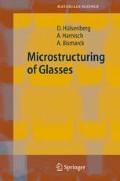Chemical etching enables geometrical structuring of workpieces by removing the material using chemical or electrochemical reactions [430]. Chemical etching processes can be performed in the liquid (wet etching) or gaseous phase (dry etching). Pure electrochemical processes, however, are only important for the etching of metals and will not be discussed here.
The visible ablation of material during the etching process is effected by chemical interphase reactions. In addition to the chemical interphase reactions, physical interactions, e.g. diffusion, adsorption, streaming, impact, are also involved in the complex process of etching. In the sequence of the manifold influences the effect of the lowest speed is controlling the complete process [430].
To utilize chemical etching processes for the geometrical structuring of materials, it is necessary to ensure a selectivity of the etching process, which again is possible by using an etch mask (Fig. 6.1). The masking process uses a protective layer on the surface of a workpiece. These protective layers have to be structured and the areas of the workpiece not to be removed protected against chemical attack. Historically, wax was often used for masking the workpieces. However, the main problem of waxes is their limited chemical stability; nevertheless, structures in the range of micrometres can be created. The structure is basically drawn into the wax layer, which is rather labour intensive and not suitable for complex geometries. Nowadays, photoresists are used for the structuring of the protective layer, which can be performed by lithography (see Fig. 4.6). The problem of photoresists is their limited chemical stability and also the adhesion between the layer and the substrate surface, which affects the success of the structuring process especially during the etching process in HF solutions. Metal layers can also be used as etching mask. In this case, the metal layer or a system of metal layers is deposited onto the surface. Afterwards, a photoresist is coated onto the metal layer, which is lithographically structured. Then the structure is transferred into the metal layer, for instance by dry etching followed by the removal of the photoresist, and only then the underlying workpiece can be structured wet chemically. Finally the metal layer will be removed.
Access this chapter
Tax calculation will be finalised at checkout
Purchases are for personal use only
Preview
Unable to display preview. Download preview PDF.
Rights and permissions
Copyright information
© 2008 Springer-Verlag Berlin Heidelberg
About this chapter
Cite this chapter
(2008). Chemical and Complex Structuring Processes. In: Microstructuring of Glasses. Springer Series in Materials Science, vol 87. Springer, Berlin, Heidelberg. https://doi.org/10.1007/978-3-540-49888-9_6
Download citation
DOI: https://doi.org/10.1007/978-3-540-49888-9_6
Publisher Name: Springer, Berlin, Heidelberg
Print ISBN: 978-3-540-26245-9
Online ISBN: 978-3-540-49888-9
eBook Packages: Physics and AstronomyPhysics and Astronomy (R0)

